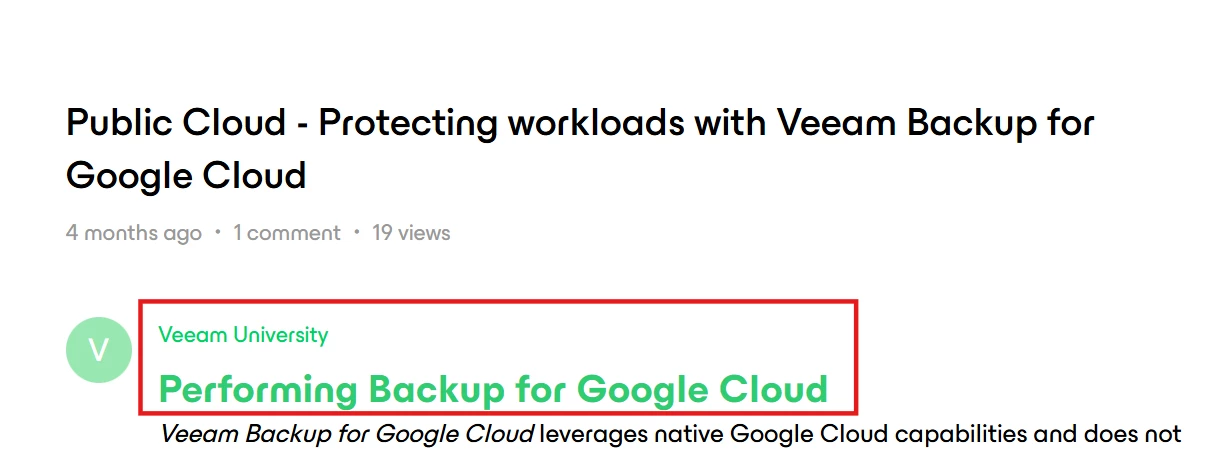Performing Backup for Google Cloud
Veeam Backup for Google Cloud leverages native Google Cloud capabilities and does not require the installation of agent software to retrieve data to perform the backup operation.
Learn more about the different ways to protect workloads in Google Cloud:
Create cloud-native snapshots of VM instances
A cloud-native snapshot includes point-in-time snapshots of persistent disks attached to the processed VM instance. Snapshots of persistent disks (also referred to as PD snapshots) are taken using native Google Cloud capabilities. By default, cloud-native snapshots are stored in the multi-regional location closest to the region in which the original instance resides. Still, the area can be changed in the backup policy settings.
Create image-level backups of VM instances
In addition to cloud-native snapshots, you can protect your VM instances with image-level backups. An image-level backup captures the whole image of the processed VM instance (including OS data, application data, and so on) at a specific point in time. The backup is saved as multiple files to a storage bucket in the native Veeam format.
Create cloud-native snapshots of Cloud SQL instances
A cloud-native snapshot is a point-in-time snapshot of the processed Cloud SQL instance. Snapshots of Cloud SQL instances are taken using native Google Cloud capabilities. By default, cloud-native snapshots are stored in the multi-regional location closest to the region in which the original instance resides.
Cloud-native snapshots of Cloud SQL instances are referred to as backups in Google Cloud documentation. However, since all 'backups' of a Cloud SQL instance are automatically deleted after you remove the instance itself, 'backups' of Cloud SQL instances are referred to as snapshots in this guide. In terms of Veeam logic, backups are independent files that are stored in backup repositories and that are not affected by any actions performed with the original instances whatsoever.
Create image-level backups of Cloud SQL instances
In addition to cloud-native snapshots, you can protect your Cloud SQL instances with image-level backups. An image-level backup captures the whole image of the processed Cloud SQL instance (including the instance configuration, databases, triggers, stored procedures and users) at a specific point in time. The backup is saved as multiple files to a storage bucket in the native Veeam format.
Veeam Backup for Google Cloud allows you to protect MySQL and PostgreSQL instances. SQL Server instances are not supported. For more information on types of Cloud SQL instances, see Google Cloud documentation.
To schedule data protection task to run automatically, create backup policies. For VM, CloudSQL and Cloud Spanner instances living in any of the regions added to the backup policies, you can also take cloud-native snapshots manually when needed.
Providing data protection for VM instances, Cloud SQL instances, and Cloud Spanner instances using native Google Cloud capabilities.
Performing Restore for Google Cloud
Performing restores with Veeam Backup for Google Cloud allows you to recover VM instances, Cloud SQL instances, and Cloud Spanner instances in the event of data loss, accidental deletion, or system failures. It ensures business continuity and minimizes downtime by providing flexible restore options for specific cases
In various disaster recovery scenarios, Veeam Backup for Google Cloud allows you to perform the following operations using backed-up data:
| Vm Restore | Cloud SQL Restore |
| Restore VM instances, disks, and files from cloud-native snapshots or image-level backups to the original or new location. Veeam Backup for Google Cloud offers the following restore operations:
You can restore VM instance data to the most recent state or any available restore point. | Restore Cloud SQL instances (from cloud-native snapshots or image-level backups) and Cloud SQL databases (from image-level backups) to the original or new location. Veeam Backup for Google Cloud offers the following restore operations:
You can restore Cloud SQL instance data to the most recent state or any available restore point.
|



